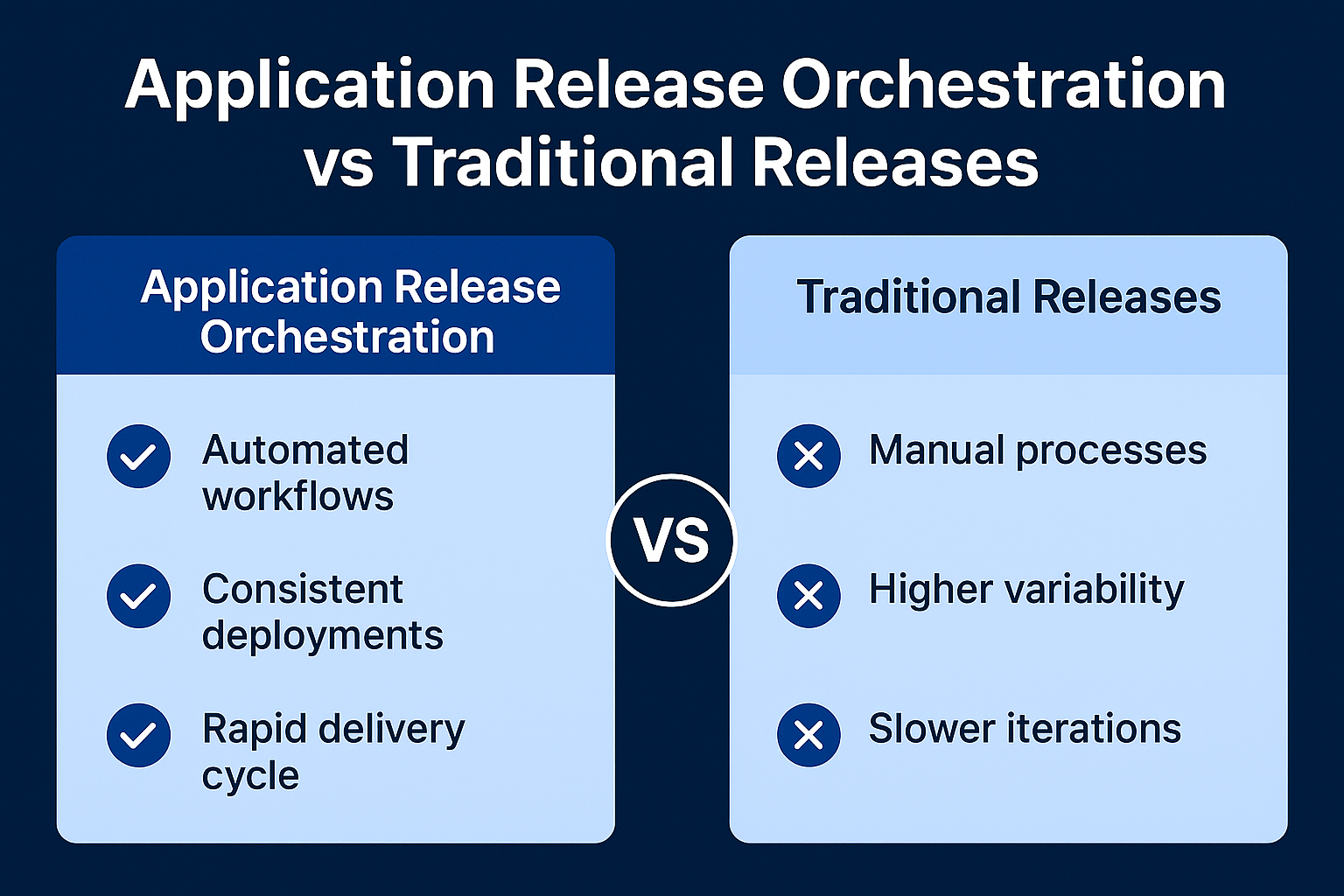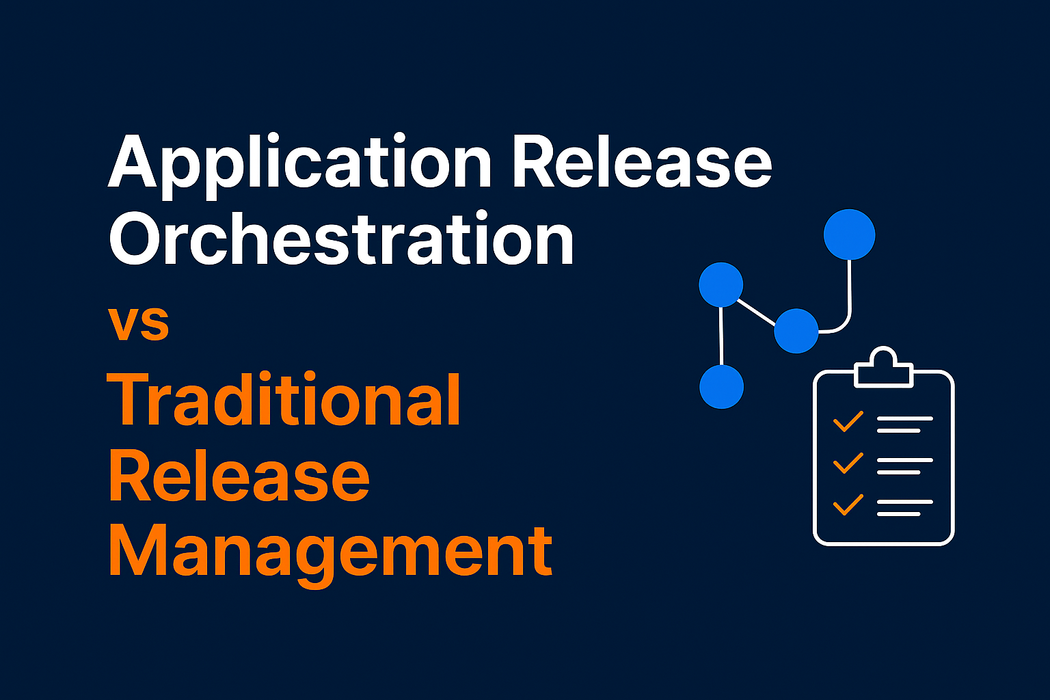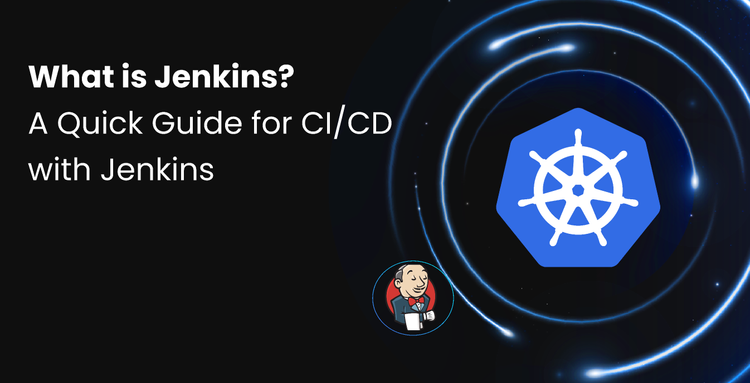1. Traditional release management is outdated and unscalable – Manual checklists, rigid calendars, and siloed tools fail in today’s microservices and multi-cloud environments.
2. Application Release Orchestration (ARO) is the modern standard – ARO brings automation, governance, and observability into software delivery, enabling faster, safer, and scalable releases.
3. Real-world benefits of ARO are game-changing – Teams see up to 182x more deployments, 24x faster lead times, and dramatic drops in failure rates.
4. Devtron simplifies ARO for Kubernetes environments – With GitOps delivery, multi-cluster management, policy gating, and one-click rollbacks, Devtron makes orchestration accessible to all teams.
5. Now is the time to switch – Staying on traditional release processes slows you down and increases risk, while ARO empowers teams to deliver with speed, stability, and confidence.
Introduction: Why the Future Belongs to ARO
Let me start with a question: When was the last time a release went out exactly as planned - on time, with no fire drills, no missing approvals, and no last-minute bugs?
If you had to pause before answering, you’re not alone. Software releases, even today, can still feel like orchestrating a symphony with half the instruments missing. The old ways of doing things (a.k.a. Traditional Release Management) just don’t cut it anymore, especially in a world where businesses expect speed, scale, and stability.
That’s where Application Release Orchestration (ARO) steps in. It’s more than just a buzzword - it’s the engine behind modern software delivery, especially in cloud-native and Kubernetes environments.
In this article, we’re going to break down:
- What traditional release management looked like
- What ARO brings to the table
- How do they compare in real-life scenarios
- Why you (and your team) need to move forward with ARO to stay competitive
Whether you’re a developer tired of waiting for someone to approve your deployment, an ops engineer dealing with rollback nightmares, or a release manager trying to keep spreadsheets in sync with Jira tickets, this is for you.
Traditional Release Management: A Legacy of Coordination Headaches
Let’s be honest, traditional release management was built for a different era. When monoliths ruled and deployments happened once every few months, this model worked:
- Rigid release calendars
- Manual checklists
- Handoffs between dev, QA, and devops
- Approval meetings and emails
- "All-hands-on-deck" Friday night releases
Sound familiar?
You probably had some Jenkins jobs running here, maybe a shared spreadsheet there, and a group email thread titled “Deployment Plan FINAL FINAL v2.” It was messy. And as the number of services, environments, and team members grew, the cracks began to show.
Let’s face it, traditional release management just doesn’t scale. Especially when:
- You're deploying 20+ microservices
- Your infrastructure is hybrid or multi-cloud
- You need strict compliance and traceability
- You want to release 10 times a day, not 10 times a year
The result? Long lead times, missed windows, failed deployments, and frustrated teams.
Application Release Orchestration (ARO): The New Standard
Application Release Orchestration is not just automation—it’s coordination, control, and compliance baked into every release. It’s the modern DevOps answer to complex delivery pipelines.
Here’s what makes ARO different:
- Pipelines are automated, observable, and consistent
- Governance (like approvals and compliance checks) is integrated into workflows
- Rollbacks, progressive delivery, multi-cluster deployments—all orchestrated automatically
- Everything is versioned, traceable, and audit-ready
e.
A Quick Comparison: Traditional vs ARO
| Feature | Traditional Release Management | Application Release Orchestration |
|---|---|---|
| Process | Sequential, manual, calendar-driven | Continuous, automated, pipeline-driven |
| Scalability | Struggles with parallel/microservice releases | Built for multi-app, multi-env, multi-team |
| Tooling | Siloed, glued-together systems | Unified dashboard with integrations |
| Compliance | Manual checks and external logs | Built-in policy enforcement and audit trails |
| Rollbacks | Manual, risky, and time-consuming | One-click, version-controlled |
| Dev Experience | Hand-offs, limited visibility | Self-service, instant feedback |

Stats Don’t Lie: The ROI of Orchestration
When elite DevOps teams embrace orchestration, the results are staggering:
- 182x more frequent deployments
- 2,293x faster recovery from failures
- 24x faster lead times
- Change failure rate drops to ~5% (compared to 40%+ in traditional setups)
(Source: 2024 DevOps Performance Benchmarks)
And here’s something even more telling: only 19% of teams qualify as elite performers, while 25% are still struggling at the bottom. The gap is widening.
Ask yourself: which side of that gap are you on?
Real-World Scenarios: Where ARO Shines
Let’s put this into real-life situations:
Coordinated Feature Rollout: You’re launching a new feature that spans frontend, backend, and infrastructure. Traditional methods? Chaos. ARO? Backend ships first, frontend follows after health checks, all automated.
Compliance Requirements: Finance or healthcare release? Traditional: email-based approvals. ARO: digital approvals, audit trails, policy gates all embedded.
Canary or Blue-Green Deployments: Traditional: risky and manual. ARO: out-of-the-box support, traffic shifting, real-time metrics monitoring.
Multi-Cluster Releases: If you’ve ever SSH’d into 3 different clusters to deploy one app, you’ll love ARO. It handles all clusters from one dashboard, with consistent behavior.
Rollbacks and Recovery: One failed script in traditional methods means downtime. ARO lets you roll back with a click, using tracked release history.
Devtron: A Kubernetes-Native ARO Platform That Gets It Right
Let’s talk tools - because not all ARO platforms are created equal. If your stack is Kubernetes-heavy or you are trying to migrate to Kubernetes, Devtron deserves your attention.
Unlike older platforms trying to retrofit orchestration into legacy systems, Devtron is built from the ground up for Kubernetes and cloud-native environments. It combines:
- GitOps delivery
- CI/CD pipeline orchestration
- Multi-cluster management
- Role-based access, policy gating
- One-click rollbacks and observability hooks
Devtron helps solve the ARO problem by giving teams a structured way to release applications without getting overwhelmed by Kubernetes’ complexity. You get a unified interface that simplifies rollouts, integrates easily into your current workflows, and keeps everything traceable, without locking you into a rigid process.
And it doesn’t stop at deployment, it’s a Software Distribution Hub. That means devs, ops, and QA work in the same interface, reducing context switching and human error.
Teams using Devtron report:
- 80% reduction in release coordination time
- 60% drop in post-release bugs
- Up to 3x increase in release frequency
All of this, while improving compliance, transparency, and team morale.
Why Now? Why You?
Let me ask you this: if your competitors are releasing daily, learning from real-world feedback, and iterating quickly, while you’re stuck in change review meetings and late-night war rooms… who’s going to win?
Modern application delivery demands more than good code. It demands reliable, scalable, and observable release processes. That’s what ARO gives you.
And no, it’s not just for the Netflixes or Googles of the world. Tools like Devtron have made orchestration accessible for every team, especially those living in Kubernetes.
TL;DR: Make the Switch
If you’re still running releases the old way, you’re:
- Slowing down your delivery
- Increasing your risk
- Burning out your teams
But with Application Release Orchestration, you get:
- Faster, safer, and smarter releases
- Real-time visibility and compliance
- Happier teams and customers
We’re not saying change is easy. But the payoff? Totally worth it.
So go ahead, rethink your release strategy. The future is orchestrated.
FAQs
What is Application Release Orchestration (ARO)?
Application Release Orchestration (ARO) is a modern approach to software delivery that automates, coordinates, and manages application releases across complex environments. It integrates governance, compliance, and observability into release workflows for faster and safer deployments.
How is ARO different from traditional release management?
Traditional release management relies on manual processes, rigid calendars, and siloed tools, which do not scale for microservices or multi-cloud environments. ARO, on the other hand, uses automated pipelines, integrated policy checks, and centralized dashboards to streamline releases and reduce errors.
Why do modern DevOps teams need Application Release Orchestration?
Modern DevOps teams need ARO to handle increasing deployment frequency, multi-cluster environments, and compliance requirements. ARO enables faster time-to-market, minimizes downtime with one-click rollbacks, and improves developer experience with self-service capabilities.
Is Application Release Orchestration only for large enterprises?
No. While ARO is essential for large-scale environments, modern platforms like Devtron make orchestration accessible for small and mid-sized teams as well. Whether you manage a few services or hundreds, ARO scales to meet your delivery needs.











